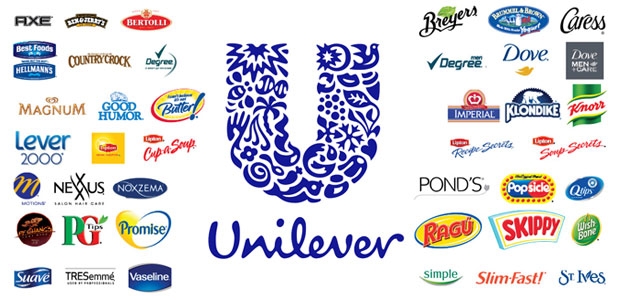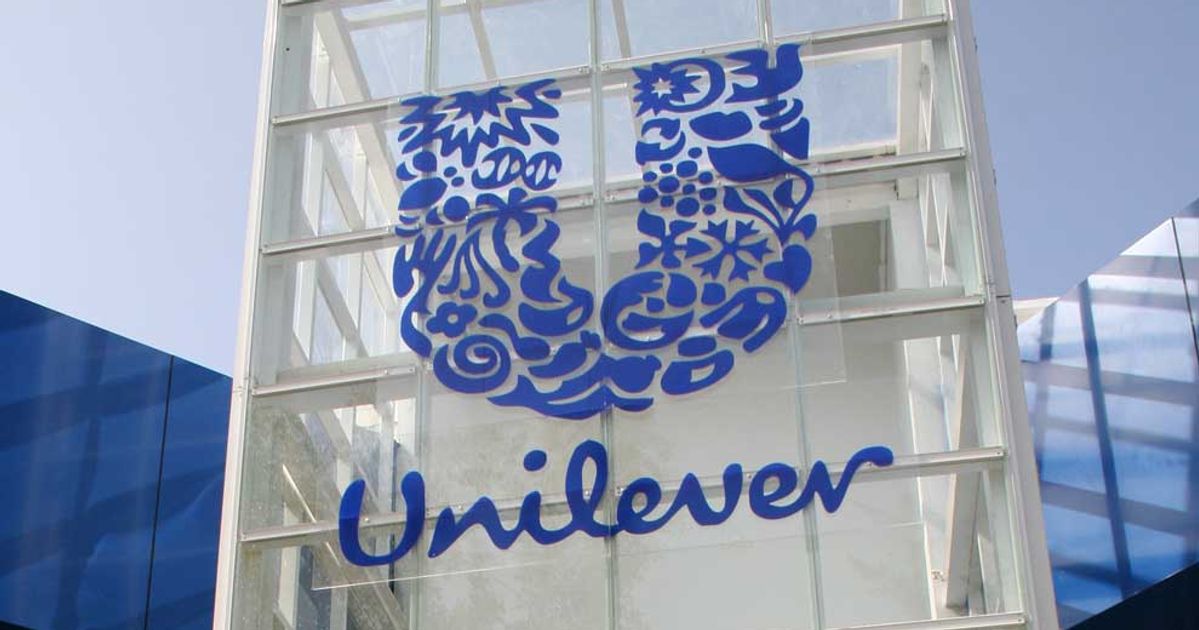Step into any supermarket aisle, and chances are you’ll encounter a product from Unilever. This multinational giant, with a rich 140-year heritage, touches the lives of millions across 190 countries. Born from the 1929 merger of British soap maker Lever Brothers and Dutch margarine producer Margarine Unie, Unilever has blossomed into a global powerhouse, offering a staggering variety of everyday essentials.
Unilever’s strength lies in its diverse portfolio that spans across personal care, home care, food and beverages, and even ice cream. Iconic brands like Dove and Sunsilk grace bathroom shelves, while Lifebuoy and Rexona ensure hygiene. In kitchens, Hellmann’s mayonnaise and Knorr seasonings add flavor, and Lipton tea provides a comforting brew. Families indulge with Magnum and Ben & Jerry’s ice cream, while Sunlight and Cif keep homes sparkling clean. Over 400 brands strong, Unilever caters to a vast array of needs.

But Unilever goes beyond just products. Driven by the powerful purpose of making sustainable living commonplace, the company actively reduces its environmental footprint, sources responsibly, and empowers communities. They champion social causes like gender equality and diversity, earning them recognition as a responsible corporate citizen.
This commitment to sustainability isn’t just lip service. Unilever sets ambitious goals, like achieving carbon neutrality and zero waste across their operations. They invest in renewable energy, sustainable packaging, and responsible sourcing practices. Their efforts have earned them recognition as a sustainability leader, setting a positive example for other companies.
Innovation is another key driver of Unilever’s success. Their dedicated research and development teams constantly work to improve existing products and develop new ones that meet evolving consumer needs. They embrace emerging technologies and trends, ensuring their brands remain relevant and exciting.
With a global workforce of 140,000 dedicated employees and a strong commitment to sustainability and innovation, Unilever remains a dominant force in the consumer goods industry. As they continue to evolve and adapt, their impact on our everyday lives is undeniable. Whether you’re cleansing your face with Dove, indulging in a Ben & Jerry’s scoop, or keeping your home spotless with Cif, you’re interacting with a company that’s shaping the future of consumer goods.
Marketing Strategies of Unilever
Unfamiliar shelves would greet you without Unilever’s brand presence. But how did this household name become a global giant? This piece unveils the key marketing strategies behind their success. We’ll dissect their diverse brand portfolio, emotional storytelling, and purpose-driven campaigns. Discover how they leverage influencers, digital platforms, and data to stay ahead. It’s a masterclass in marketing, offering valuable lessons for any business aiming to capture hearts, minds, and market share. Buckle up – it’s time to unlock the secrets of Unilever’s marketing strategies –
1. Brand Portfolio Diversification
Unilever doesn’t put all its eggs in one basket; it thrives on diversification. Their 400-brand portfolio, spanning food, beverages, personal care, and home care, mitigates risk and ensures stability amidst market fluctuations.
Spreading the wealth across categories and geographies is key. Beauty & Personal Care, Food & Refreshment, and Home Care each contribute significantly, around 40% and 20% respectively, preventing overreliance on any single segment. This geographical diversification is evident in their global presence, further strengthening their position.
Powerhouse brands like Dove, Hellmann’s, and Omo (Persil) lead the charge, anchoring each category. But innovation fuels growth. By organizing into five business groups (Beauty & Wellbeing, Personal Care, Home Care, Nutrition, and Ice Cream), Unilever fosters agility and adaptability to ever-changing consumer preferences. This allows them to capitalize on new trends and cater to diverse needs across the globe.
Unilever’s brand portfolio diversification isn’t just about quantity; it’s about strategic spread and calculated risk management. By building a strong presence in various categories and regions, they navigate market shifts with resilience and ensure long-term growth, solidifying their position as a global leader in consumer goods.
2. Emotional Branding
Unilever doesn’t just sell soap and ice cream; they touch hearts and build connections. Their emotional branding goes beyond traditional advertising, resonating with deeper human values and aspirations.
The campaigns showcase their mastery:
- Dove’s Real Beauty campaign shattered traditional beauty standards, celebrating diversity and self-confidence. This empowered women and fostered brand loyalty beyond just product quality.
- Lifebuoy’s Help a Child Reach 5 campaign tackled childhood mortality in developing countries. This emotional appeal connected consumers to a larger purpose, driving sales and positive social impact.
- Ben & Jerry’s social activism integrates seamlessly with their brand personality. Their commitment to social justice resonates with consumers who value similar principles, creating a deeper bond.
These campaigns aren’t just feel-good ads; they’re strategic moves. They tap into universal emotions like love, hope, and community, building authentic connections that transcend product features.
The results speak for themselves. Increased brand loyalty, positive brand perception, and even sales growth demonstrate the power of emotional branding. By understanding their audience’s values and aspirations, Unilever creates meaningful connections that go beyond the shelf, solidifying their position as a brand with a heart.
3. Sustainability and Purpose-driven Marketing
Unilever transcends mere marketing; they weave sustainability and purpose into their brand DNA. This strategy resonates with consumers seeking brands that align with their values.
Sustainable Living Brands like Ben & Jerry’s and Seventh Generation champion social and environmental causes, offering products that contribute to Unilever’s ambitious goals. This authenticity fosters trust and brand loyalty.
The Sustainable Living Plan sets the stage, outlining tangible commitments to improve a billion lives and reduce their environmental footprint. From improving hygiene with Lifebuoy to tackling climate change with renewable energy, their actions speak louder than words.
Unilever Compass charts their course, setting clear targets for net zero emissions, plastic reduction, and agricultural regeneration. This commitment to a healthier planet resonates with environmentally conscious consumers, building deeper connections.
While acknowledging challenges, Unilever remains steadfast. Their sustainability marketing, though evolving, is paving the way for a future where brands act as forces for good. By integrating purpose into their core, they inspire consumers, build trust, and solidify their position as a leader in responsible business practices.
4. Influencer Collaborations
Unilever goes beyond celebrity endorsements, forging meaningful collaborations with diverse influencers. This strategy amplifies their message and connects with audiences in authentic ways.
Leveraging trending platforms: Collaborations like #CleanTok tap into popular trends and communities, reaching new audiences organically. They even create awards like #CleanTok Awards to incentivize influencer engagement and celebrate content creation.
Championing causes and communities: By sponsoring the FIFA Women’s World Cup and partnering with influencers, Unilever goes beyond marketing, supporting causes they care about and connecting with passionate communities.
Empowering creators: Their Creator Council fosters collaboration and provides resources for influencers, non-profits, and brands. This ecosystem cultivates trust and empowers creators to produce authentic content aligned with Unilever’s values.
Tackling harmful stereotypes: Recognizing the power of representation, Unilever launched the “10 Ways to Unstereotype Influencer Brand Content” guide. This empowers influencers to create inclusive content and ensures responsible partnerships, addressing a critical social issue.
Unilever’s influencer strategy isn’t just about reach; it’s about impact. By collaborating with diverse voices, supporting causes, and fostering ethical content creation, they build trust, resonate with audiences, and position themselves as a brand that champions progress and inclusivity.
5. Cause Marketing
Unilever doesn’t just sell products; they champion causes, aligning their brand with global issues and demonstrating their commitment to social impact. This cause marketing strategy resonates with consumers seeking brands that share their values.
It is clearly visible in some of their brand’s campaign:
- Domestos’ World Toilet Day initiative tackles sanitation issues in underserved communities, providing access to basic hygiene and improving lives.
- Dove’s Campaign for Real Beauty confronts beauty stereotypes, empowering women and fostering self-acceptance.
- Omo/Persil’s “Dirt is good” campaign encourages messy play, recognizing its importance in children’s development.
- Carrotmob mobilizes consumers to support businesses making a positive social impact, aligning with Unilever’s values.
Their CEO’s statement rings true: brands lacking a strong purpose risk irrelevance. By taking a stand on issues like sanitation, self-esteem, and mindful consumption, Unilever builds deeper connections with consumers, earns their trust, and positions itself as a force for good in the world.
Unilever’s cause marketing isn’t just philanthropy; it’s a strategic decision. It strengthens their brand image, attracts purpose-driven consumers, and ensures they remain relevant in an increasingly values-driven marketplace.
6. Data-driven Marketing
Unilever doesn’t rely on hunches; they harness the power of data to drive personalized experiences, targeted campaigns, and innovative products. This data-driven approach ensures their marketing aligns with consumer preferences and maximizes impact.
First-party data unlocks personalization: By leveraging data from loyalty programs and website interactions, Unilever crafts relevant communications and offers, fostering deeper customer connections. It’s not just mass marketing; it’s personal engagement driven by insights.
Data fuels innovation: Gone are the days of guesswork product development. Unilever analyzes consumer needs and preferences to identify gaps in the market and ideate products that resonate with their target audience. Data empowers them to bring solutions consumers truly crave.
Digital hubs power targeted campaigns: From social media marketing to personalized email campaigns, Unilever leverages data-driven insights to deliver targeted messages that reach the right audience at the right time. No more scattershot marketing; each campaign is laser-focused for maximum impact.
Humans in the loop, data at the core: While advanced data platforms crunch the numbers, Unilever recognizes the human touch remains crucial. Data informs, but strategic thinking and creativity guide decision-making. It’s the perfect blend of data science and human ingenuity.
Cabinets whisper insights: Millions of connected cabinets worldwide provide Unilever with invaluable data on product usage and preferences. This real-time data stream allows them to optimize product placement, pricing, and store assortments, ensuring shelves are stocked with what customers truly want.
Unilever’s data-driven marketing isn’t just about numbers; it’s about understanding their customers. By leveraging data ethically and strategically, they deliver personalized experiences, create desired products, and run targeted campaigns, solidifying their position as a marketing leader in the data-driven age.
7. Cultural Relevance
Unilever thrives in a globalized world by weaving cultural relevance into its marketing strategy. They don’t simply translate campaigns; they adapt them to resonate with local traditions and diverse audiences. Remember Knorr’s “Love at First Taste”? This campaign celebrated how food transcends cultural barriers, connecting people through shared experiences. It’s a universal message wrapped in local flavors, a perfect example of Unilever’s approach.
But cultural relevance goes beyond individual campaigns. Unilever employs various strategies to ensure its marketing resonates globally. They leverage culture difference strategies to understand and enter new markets quickly. Their culturally diverse teams bring local and global perspectives to the table, ensuring products and services both fit local needs and appeal to a broader audience. Finally, tailored marketing messages are crafted for each market, acknowledging the unique nuances that drive consumer behavior.
With over 400 brands in their portfolio, Unilever has the flexibility to adapt and thrive in any cultural landscape. This commitment to cultural relevance isn’t just good marketing; it’s the key to their global success.
8. Strong Distribution Network
Unilever’s marketing strategy isn’t just about messaging; it’s about getting products into consumers’ hands. Their vast, global supply chain spans over 100 countries, reaching far and wide. This network isn’t static; it adapts, blending centralized control with decentralized flexibility to navigate diverse markets. They even prioritize risk assessment, ensuring responsible sourcing throughout the chain.
But the scale doesn’t stop there. Unilever collaborates with a staggering 48,000 suppliers, creating a powerful ecosystem. This collaboration isn’t just transactional; it fosters technological innovation, service resilience, and progress on social and environmental issues. It’s a win-win for everyone involved.
But what about reaching the last mile? Unilever gets creative. Their Shakti program in India empowers local women as rural sales agents, ensuring products reach even the most remote areas. This program not only boosts sales but also creates economic opportunities for these women.
Unilever’s distribution network isn’t just about efficiency; it’s about building connections and empowering communities. This strategic approach is a key ingredient in their marketing success, ensuring their products reach not just shelves, but also hearts and minds.
In a world buzzing with diverse cultures and ever-shifting markets, Unilever doesn’t just market, it adapts and thrives. By weaving cultural understanding into their messaging and leveraging a powerful, responsible distribution network, they’ve built a recipe for global success. They understand that marketing isn’t a one-size-fits-all game; it’s about speaking the language of each community and ensuring their products seamlessly integrate into lives around the world. This commitment to cultural relevance and responsible reach sets Unilever apart, making them a true marketing marvel.
Marketing Mix of Unilever
Unilever, the global consumer goods giant, orchestrates its success through a masterful blend of marketing strategies, anchored by the classic 4Ps: Product, Price, Place, and Promotion. Let’s delve into each element and see how they contribute to the company’s unique marketing symphony.
1. Product
Diverse Portfolio: With over 400 brands, Unilever caters to diverse global needs across food, home care, and personal care categories. This vast portfolio allows them to adapt to local preferences and tap into various market segments.
Innovation Powerhouse: They constantly innovate, launching new products like plant-based alternatives and personalized beauty solutions, responding to evolving consumer demands and trends.
Sustainability Focus: Unilever prioritizes sustainability, integrating it into product development and messaging, resonating with environmentally conscious consumers.
2. Price
Value-Based Pricing: They employ value-based pricing, balancing affordability with perceived value to cater to different income segments and market expectations.
Localization: Prices are adjusted based on local purchasing power and competitive landscapes, ensuring accessibility and market competitiveness.
Promotional Strategies: They leverage promotions and discounts to attract new customers, reward loyal ones, and clear inventory, while maintaining overall profitability.
3. Place
Vast Distribution Network: Unilever boasts a global reach, leveraging a network of distributors, wholesalers, and retailers to ensure product availability in diverse markets.
Omnichannel Presence: They actively engage with consumers online through e-commerce platforms and social media, complementing their traditional physical distribution channels.
Innovative Channels: They explore innovative distribution models like the Shakti program in India, empowering local women as rural sales agents, increasing accessibility in remote areas.
4. Promotion
Culturally Relevant Communication: They tailor marketing messages and campaigns to resonate with local cultures and traditions, avoiding generic approaches.
Diverse Teams: Culturally diverse marketing teams bring unique perspectives, ensuring campaigns are sensitive and effective across different markets.
Integrated Approach: They utilize a mix of traditional (TV, print) and digital marketing channels (social media, influencer marketing) to reach diverse audiences effectively.
It’s important to acknowledge that Unilever’s marketing strategy extends beyond the traditional 4Ps. They incorporate additional elements like purpose-driven marketing, aligning their brand values with social and environmental causes, and data-driven marketing, leveraging customer insights to personalize marketing efforts and optimize campaigns.
Unilever’s marketing mix is a complex and dynamic composition, where each element plays a crucial role in its global success. Their adaptability, cultural sensitivity, and commitment to innovation ensure their products resonate with diverse audiences across the world, making them a true marketing maestro.
Also Read: SWOT Analysis and STP Analysis of Unilever Plc
To read more content like this, subscribe to our newsletter
Go to the full page to view and submit the form.


